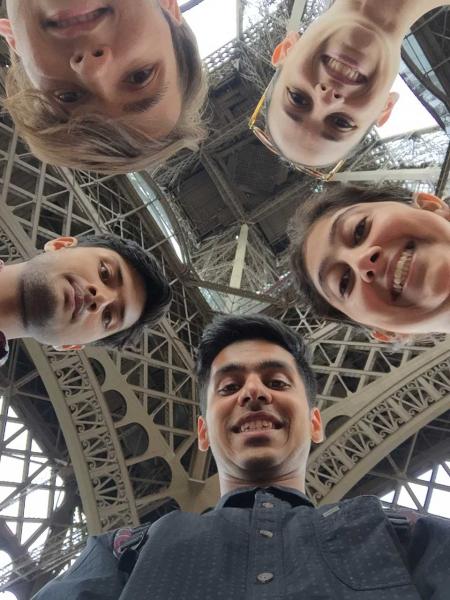This article originally appeared at International Science Grid This Week.
Each year, students from all over the world come to CERN as part of the CERN openlab Summer Student Programme. As well as attending lectures and working on their research projects, several of this year’s students decided to come together to take part in the recent CERN Summer Student Webfest, which saw participants hack their way through an entire weekend to produce a range of weird and wonderful science-related innovations.
Read this first-hand account of what it was like to take part in the event from the ‘Open Cosmics’ team. They were awarded the ‘Best Innovative Outreach’ prize for their work to open up data from cosmic ray detectors to the world.

Summer students, assemble
A little over a month ago, we were just a modest bunch of students from all corners of the world — with no idea what we were in for. It was not long, however, before a bond of friendship was created between us. Thus, when the opportunity to work together in the CERN Summer Student Webfest arose, our reaction was simply “where can we sign up?” For two of us, it was actually our first experience of taking part in such a hackathon, which made it all the more exciting!
We love any opportunity to code, so all we needed was an idea. We began discussing and pitching ideas weeks before the webfest, but it wasn’t until two days before the start of the event that Anirudha came up with the idea to work with cosmic rays. We immediately began our research and contacted people involved in the field.
A cosmic idea
High-energy cosmic beams hit the Earth’s outer atmosphere, which in turn scatters these rays into a shower of particle decays. Simple devices like cloud chambers, bubble chambers, and the Cosmic Pi enable us to detect particle decays which are not otherwise visible to the naked eye.
Our plan was to build a distributed network of these devices, which will be able to capture these cosmic events around us. This could then be used to analyse data, as well as for examining results and disseminating them to the public. Thus, we hope to make it possible for non-physicists, students, and hobbyists to play with this data and learn more about the fascinating cosmos around them.
We worked to make the platform capable of filtering the raw data, as well as storing the information following enhancement using image-processing techniques. By applying pattern-recognition methods to ascertain particle tracks, our system is able to determine what type of particle has been detected. Even simple information about the arc of a track can tell us the speed and mass of the particle.
Meeting the experts
The morning before the webfest, we went all around CERN to meet people involved with detectors; we first met Hugo Day from the Cosmic Pi project, who then referred us to CERN’s S'Cool LAB for access to the cloud chambers. Here we met Jeff Wiener, the founder of S’Cool LAB, and Julia Woithe, who kindly allowed us into their lab to view the cloud chamber and gather data first hand. On the other side of the globe, we had also already made contact with Matthew Bellis from Siena College in New York, who organizes workshops for students and high-school teachers on how to make DIY cloud chambers!
On Friday afternoon, our idea for the webfest was pitched by Siddha, so that anybody interested could join us and we could then get down to coding as soon as possible. A party was also organized by the webfest team that evening, which presented a good opportunity to clarify the ideas and explain them further. We met some great people, like Ben Segal, an honorary CERN member and chief technology officer of the Citizen Cyberscience Centre (CCC). He liked our idea and agreed to be our team’s mentor. Furthermore, we shared our idea with Francois Grey, coordinator of the CCC, who referred us to Daniel Lombraña González, senior researcher at the CCC and co-founder of the Crowdcrafting website. He turned our idea into a citizen science project, making it possible for absolutely anyone to learn about the trails of particles and help in classifying data.
Race to the finish
The following morning, everyone was energized and ready to get down to business. Throughout the day, there were discussions going on, new contacts being made, people learning new things, and everybody was having a good time. Together with a handful of other teams, we somehow even managed to code through the night!
On Sunday, the final day of the webfest, each team raced to complete their projects on time. The final presentations took place in the afternoon, and it was very interesting to see how all the ideas turned out.
The webfest was an amazing experience for every single one of us; one which we will never forget. And, to top it all off, we won the award for ‘Best Innovative Outreach’! Not only that, but there was also another team in the webfest with CERN openlab summer students participating, and they too won a prize: They received the award for ‘Best Design’!
CERN openlab is a unique public-private partnership between CERN and leading ICT companies. Its mission is to accelerate the development of cutting-edge solutions to be used by the worldwide Large Hadron Collider (LHC) research community.
